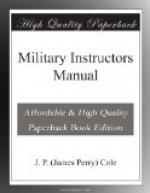3. The details are marched to the parade ground by the senior non-commissioned officers, halted and dressed as follows:
FIRST DETAIL.—Non-commissioned officer.—1. Detail; 2. Halt. The detail is halted against the left arm of the Sergeant Major; the non-commissioned officer steps out, faces the Sergeant Major at a distance slightly greater than the front of the detail and commands: 1. Right; 2. Dress. The detail dresses on the line formed by the Sergeant Major and the Commander of the detail. 3. Front. The Commander of the detail salutes and reports: “The detail is correct” (or otherwise). When the report is made the Sergeant Major returns the salute. The Commander of the detail passes by the right of the guard and takes post in rear of the right file of his detail.
OTHER DETAILS.—Non-commissioned officers.—1. Detail; 2. Halt; 3. Right; 4. Dress; 5. Front. Each commander of a detail halts his detail, dresses it on the general line, salutes and reports as does the first; then takes his post in a similar manner. Should the commander of a detail not be a non-commissioned officer he passes by the right of the guard and retires.
4. SERGEANT MAJOR.—He takes one step to the right, draws sword and verifies the detail, and then commands: “Count off.” He completes the last squad if necessary and indicates the division into platoons: then takes his post and commands: 1. Open ranks; 2. March. This is executed as laid down in the Infantry Drill Regulations. 3. Front. He then moves parallel to the front rank until opposite the center, turns to the right, halts half-way to the Adjutant, salutes and reports: “Sir, the details are correct” (or otherwise).
5. ADJUTANT: “Take your post.” (Adjutant draws saber.)
6. SERGEANT MAJOR.—Faces about, approaches to within two paces of the center of the guard, turns; to the right and moves three paces beyond the left of the guard, turns to the left, halts on the line of the front rank, faces about and brings his sword to the order. (When the Sergeant Major has reported the Officer of the Guard takes his post, as shown in the diagram, and draws saber.)
7. ADJUTANT.—1. Officer (officers) and non-commissioned officers; 2. Front and center; 3. March. At “Center” the officer carries saber; at “March” the officer advances and halts 3 paces from the Adjutant, remaining at the carry; non-commissioned officers pass by the flank, move along the front and form in order of rank from right to left, 3 paces behind the officer, remaining at the right shoulder. If there is no officer of the guard the non-commissioned officers halt 3 paces from the Adjutant. The Adjutant assigns them to their positions in order of rank—commander of the guard; leader of the first platoon; leader of the second platoon, etc., and commands: 1. Officer (officers) and non-commissioned officers; 2. Posts; 3. March. At the command “March” they take their posts as prescribed in the School of the Company with open ranks (Platoon leaders 3 paces in front of center of their platoons).




